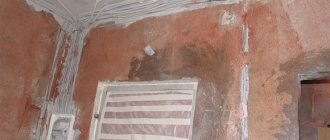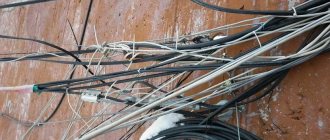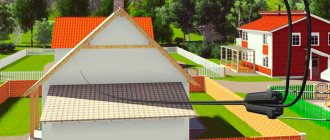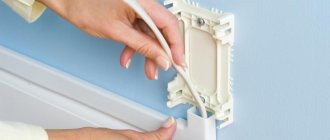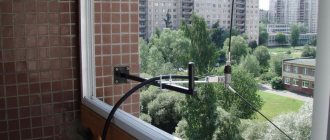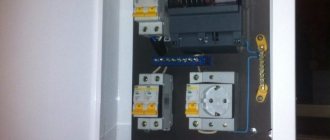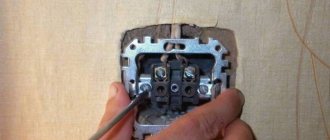What is a wire fastener?
Wire fasteners are made from various materials, having one function - to prevent the cable from sagging above the surface where it passes. Fastening the cable from the inside of the room ensures open or closed passage of single wires or a group of cables.
Such devices are placed on the walls, which are a kind of springboard for placing electrical wires. How the cable will be attached to the wall surface depends on the choice of fastening equipment. And also from installing an element for fastening wires.
Nuances
Wiring along a ceiling or wall has its own nuances:
- Screws, screws and dowels must fit tightly to the required surface. If this condition is not met, damage to the insulation system may occur;
- The distance between the holes when fastening does not exceed 50 cm. If there are turns, then it is possible to reduce this distance by 5-10 cm;
- The cable is pulled vertically or horizontally on a flat surface. Laying over uneven surfaces is prohibited;
- A supply of wires is possible, but it should be as inconspicuous as possible during installation;
- Hidden installation of wires in the groove implies the presence of excess space, which will allow it not to interfere with the repair of walls;
- A container in the surface is not made for wires if the ceiling covering is made using a modern method (stretch and suspended ceilings);
- You should have special tools available for wiring installation (drill, hammer drill, screwdriver and hammer).
Methods of fastening to walls made of various materials
It is a mistake to believe that wiring can be fixed to any flat surface. Load-bearing structures and partitions are constructed from materials with different properties:
- thin, soft;
- dense;
- solid.
Wall surfaces made of porous materials (foam, aerated concrete) are considered soft. This group also includes plasterboard, plastic, and fiberboard. These materials are able to withstand moderate loads, but are deformed under the influence of strong pressure. To prevent destruction of the entire structure, you should choose methods for attaching the cable to the wall based on the use of fasteners that have an extended middle/end part. These can be dowels of different types.
The group of dense materials includes chipboard, wood, and gypsum. Surfaces covered with plaster are also durable. The top layer of the material has a dense structure. If the question of how to fix the cable on such a wall is being decided, two options are considered: nails, self-tapping screws.
The first one is less reliable. Such fasteners can be dispensed with if they are used as a temporary measure or if this area will not be used in the future. Due to mobility, the strength of fixation of the nail in the wall decreases. To secure the screws, holes of a smaller diameter are first made. However, this measure is used only if the fasteners are difficult to install.
Installation
The work of creating channels for wiring begins with a special tool - a pipe cutter. He makes special holes for electrical wires.
- They are secured with metal staples, plaster and dowel clamps.
- Next, the walls undergo further finishing to close the necessary spaces; they are painted or covered with wallpaper.
- The wires lead to power boxes, sockets and switches.
Important! If the walls have not been plastered, then there is no need to create channels with a pipe cutter. Also, the wiring elements must be positioned so that the installation of the surface removes all unnecessary protrusions from the wires.
Creating hidden wiring differs significantly from open installation. After all, creating the first option requires special equipment, as well as a lot of time and painstaking manual labor. After this process, a lot of dust and dirt remains.
Securing exposed wires is a less labor-intensive operation where the wires remain on the surface. In order for these devices to fit perfectly into the room, design tricks are used.
For example, they purchase boxes to cover electrical wires. These containers are striking in their variety of colors and are suitable for any interior.
Fastening for cables and wires: types and varieties
For any type of installation of electrical wiring and cables, the same types of fasteners can be used. It is selected based on the existing conditions, capabilities and tastes of the owners. The main task is to ensure high-quality fixation and not to disturb the insulation either during installation or during further work and operation. And you select the type of fastening from the possible options. There are quite a lot of them - there are special ones that are produced specifically for cables, there are those borrowed from other areas, and there are homemade ones.
There are many cable mounting options
Clips for cable fastening
Using clips, you can secure the cable to the wall, ceiling, or floor. You just have to choose the right design, and there are many of them. Fastening the cable with clips is a very popular method - it can turn out very neatly and almost imperceptibly. This is if open wiring is assumed.
Clips for cable installation are available in metal and plastic, and in different shapes. The simplest ones look like a bow, which has holes for screws or dowels on one side and the other. They are all good, but installation requires drilling two holes, which takes a lot of time.
There is an option that allows you to maintain a fire gap when installing the power cable on combustible surfaces (pictured on the left). This fastener is fixed to the surface with one self-tapping screw. The good thing about it is that, if necessary, you can add threads to the same fastener. To do this, you do not have to remove it; you will need to unscrew the screws holding the upper part of the clip.
Metal clips for cable fastening
The third option is a kind of loop made from a strip of metal. To install it, you first need to insert the cables inside, then align the holes and secure them to the surface.
All these clips can be used both on the wall and on the ceiling. But when laying a large number of threads on the ceiling, they are inconvenient - too many holes are required for installation. They are made of metal, some of them are then painted so that when installed externally, the fasteners stand out less.
Mounting on plastic clips
Plastic clips are used mainly for securing cables in corrugated hoses. They are available in different sizes for different corrugation diameters. They can be installed individually or assembled in lines - for more accurate installation of large wiring bundles. This type of clips is used mainly for hidden installation, but if the corrugation is laid outside, then it is more convenient to fix it with their help.
Dowel clip
A dowel-clip is more invisible during installation. This is a curved strip of plastic with characteristic branches at the ends, which, due to elastic force, will hold the fasteners in the wall or ceiling material. The shape of these products is available for round and flat cables of different sizes. But you can’t secure serious cables with them—they’re too small. But they look very neat on conductors of small cross-sections, including television, telephone and Internet.
Dowel clips for cables of various shapes
They are installed simply: a hole of a suitable diameter is drilled, a conductor is inserted into the clip, the ends are tucked into the hole and inserted there with force. It’s a really good option - it’s quick to install and looks neat. Mainly used for open wiring.
Dowel tie
Another option for quickly attaching the cable is a dowel tie. It is made from non-flammable, self-extinguishing plasticizers and allows for quick installation of cable lines. Can be used for both open and hidden installation.
A dowel tie is a quick and convenient way to secure a cable to concrete, brick and other surfaces
There is a coupler with a detachable and permanent lock. The detachable lock allows you to change the number of wires if necessary. The installation method is the same as for a regular dowel. The difference is that the dowel here is also plastic.
Cable ties with dowel platform (KSP)
Another option for quick installation. It consists of a dowel with a thread and a platform with a tie attached to it. First, a dowel is installed, and a platform with a screed is screwed onto it. Wires are attached to the finished route.
KSP - cable tie with mounting platform for dowel
Material: non-flammable plastic, color: grey, temperature of use: from -45°C to +85°C. Can be mounted on concrete, brick and wooden surfaces.
Clips (staples) with a nail
An excellent option for attaching cables to dense surfaces - wood and its derivatives, plaster. There is a hole on the side of the plastic bracket into which a nail is inserted. The shape of the brackets is round and rectangular - for different shapes of conductors.
Plastic staples with nails for exposed cable installation
Fastening the cable with such brackets is quick and unobtrusive. Most often, small wires are also attached - television, telephone, for the Internet.
U-shaped staples from a stapler
Even the smallest staples and clips are still quite noticeable. There is a way to make fasteners virtually invisible, at least in some cases. If you have a construction stapler, wires and telephone cables can be secured to wooden surfaces or plaster with special staples. They have long legs and a rounded back. There are special stapler staples designed for installing cables with plastic stops (middle picture). They do not allow the wire to be crushed, which happens when working with conventional staples if too much force is applied to the trigger mechanism.
Elements for fastening
Fastening the wiring implies the presence of various elements for its reliable fixation on the surface of the walls or ceiling.
So, how can you attach the wires:
- Self-tapping screws for soft materials - wood, chipboard and MDF;
- Nails for soft materials;
- Self-tapping screws and dowels for hard materials - stone, plastic, concrete and metal;
- Clips for gluing wires to a surface;
- Panel ties;
- Clamps for fastening wires.
Methods of attachment to different surfaces
Walls and ceilings are made from various materials with different structures and densities. Depending on this characteristic, the method of fastening changes:
- Dense - wood in any form, plaster and soft plaster solutions (including gypsum). A nail or self-tapping screw fits perfectly into all these materials. In some - OSB and some others - it is better to first drill a hole with a slightly smaller diameter than a self-tapping screw, and then screw it in. Nails are often driven in immediately without pre-drilling.
Self-tapping screws are screwed into wood and products made from it. Only for attaching the cable it is better to take them with a flat head
- Solid. This category of materials includes brick, concrete, screeds, and cements. You can’t screw a self-tapping screw into them even with a pre-drilled hole. For such materials, dowel-nails are used (they are also called dowels). This is a fastener consisting of two parts - a plastic dowel cap and a metal (sometimes plastic) screw. In such cases, a hole is drilled in the material with a drill diameter equal to or slightly smaller than the diameter of the dowel. A plastic cap is inserted into the hole. Its top edge should be flush with the surface (if necessary, you can hit it a couple of times with a hammer to level it or cut off the excess with a sharp knife). Then a fastening element (plate, clamp, etc.) is applied, which is attached to the inserted dowel with a screw.
Dowel installation
- Thin or soft. These are plastic, plasterboard, fiberboard, aerated concrete, foam concrete, etc. The usual fasteners do not hold in them; you need a special one, which has an extended “back” part. It has a large support area, due to which the fasteners can be held. Some examples of such fasteners (umbrella, butterfly dowel and dowel with drill) are presented in the photo.
To attach the cable to thin walls, you need special fasteners.
Actually, these are all the surfaces that are encountered inside the house when laying wiring. But sometimes the cable also needs to be attached to a pole, for example, when the electricity supply from the pole to the house stretches, or to a pipe - when the cable rises along a flammable wall.
To a concrete pillar
The cable is secured to the reinforced concrete pole with long black plastic ties. They last about 5 years.
One way to lower a cable along a reinforced concrete pole
You can use clamps to install sewer pipes, but you need to drill holes for them, which is very difficult. Another option is if there is a grounding wire on the pole - a round wire with a diameter of 5-6 mm, then you can attach it to it with ties. Another option is to attach strips of metal to the pole - make something like clamps, and attach the cable to them.
In a metal pipe
If the cable runs up the wall of a house in a metal pipe, it is simply run inside. Since quite solid cables are used for external wiring, its rigidity is usually enough to more or less stay inside the pipe.
Laying cable in a pipe. Fasten the pipe, and the cable only at the exit from it to the wall
The pipe is closed at the top and bottom with some kind of plug (can be cut out of foam plastic and then painted along with the pipe). This plug will additionally fix the position of the cable (do not press it to the edge), and so that it does not move inside the pipe, it is attached to the wall at the exit from it.
To the cable
To attach the cable to the cable, special metal and plastic hangers are used. They consist of two parts - there is a hole for the cable and a larger one for laying cables.
Suspensions for attaching the cable to the rope
Which is better - metal or plastic? Metal ones are more durable, but take longer to install - you need to tighten the screw. Plastic ones will last about 5 years, but are installed quickly - the “tail” is pulled into the corresponding hole and tightened. That's all.
Variety, characteristics
The market offers a huge number of elements for wiring installation.
The most popular types of fasteners for exposed wires:
- Rigging shackle. Has a diameter of 3-14 mm. Presented for sale with the letter P. The product has one fastening using a steel nail. Made from polypropylene. Use staples on wood, chipboard and VDF surfaces. Experts advise using these products for laying wires along wooden baseboards;
- Dowel clamp. It is a product folded in half. Made from plastic. Suitable for wires with round or flat structure. Used for fastening on concrete, brick and stone. Installation of such a product requires drilling a 6 mm hole. and further securing the clamp. If necessary, hammer it in carefully with a hammer. A very popular mount due to its low cost and easy installation;
- Screed. Available in the following sizes: 100-400 in length and width 2.5-8 mm. It is represented by a nylon product, which is equipped with notches and a lock at one end. The wire is secured with a loop. This device secures the cable very well. Features: inexpensive price and easy installation;
- Bandage. Made from nylon. The product is presented with a hole through which the bandage securely fastens the wiring. Installation takes place with a drilled hole into which a plastic dowel is inserted, and then the bandage itself using a self-tapping screw. The product is suitable for fastening large wires and corrugated cardboard structures. The cable is secured with a loop tie and the excess end of this product is cut off. The mount is ideal for both walls and ceilings.
Exposed wires
The cable fastening is carried out in some increments. The wiring remains open. For comparison, if the cable is laid in a groove, it can be completely hidden. However, it is much easier to maintain an open wire. In this case, detachable and permanent fastening elements are used. If you plan to increase the number of cores, use the first type.
Metal bracket
This type of cable fastener may have 1 or 2 ears. Fixed on the wall using nails and self-tapping screws. This type of product is used when laying cables in a metal sleeve. Withstands heavy wires. The bracket is selected taking into account the diameter of the metal sleeve.
Dowel tie
If you are interested in the question of how to fasten a cable using such products, you should know that first a dowel is inserted into the wall. It is equipped with a special lock on a flexible plastic tape. For fastening, detachable and permanent fasteners can be used. The disadvantage of this method is the lack of rigid fixation of the structure, since the dowel is simply connected to a flexible tape.
Screeds with platform
This option is externally similar to the previously discussed analogue. However, in this case, the dowel has a platform, thanks to which such an element is firmly fixed in the wall. If a flexible cable tie with a hole for a self-tapping screw is used for fastening, there is no need to use a separate dowel. This method requires the installation of self-tapping screws at some intervals.
Dowel clamp
Outwardly, it simultaneously resembles a dowel and a clamp. For fixation in the wall, there are notches located at the ends of the fastening element. First, the cable is tied, and you can attach the wire to the wall by placing a kind of dowel in a pre-made hole. The product is held in place thanks to notches - they do not allow the clamp to slip out.
How to choose the right one
The choice of products for fastening wires must be treated very responsibly. After all, if you do not calculate the size of the cable, then deformation of the products over time cannot be avoided. Therefore, when choosing fasteners, you should give preference to stronger models for heavy wiring.
Dowels and screws must be the same size and have corresponding hole diameters. If you do not take this advice into account, then wiring installation simply will not work.
Before working on fastening the wiring, it is recommended not to rush to buy the entire quantity of necessary products at once. And purchase a trial version of fasteners. This will not only save money, but also make the installation of electrical wiring as high quality as possible.
Cable in corrugation, pipe or cable channel
If open wiring is performed, this method is preferable. This is due to the fact that the wires are hidden in a corrugation or pipe, a special channel made in the form of a box. Thanks to the use of a closed design, the safety of cable operation is increased. However, this method is much less commonly used for laying large bundles of wire.
Cable channels
Existing varieties are made from:
- galvanized steel;
- plastic;
- aluminum
The cable channel can be made in the form of a rectangular box; the outer surface of some products has a radius. Such varieties are often installed along the wall: on the floor or instead of a baseboard. Other types of cable channel:
- main lines;
- parapet.
The first option is intended for laying wires over significant distances. These boxes are larger in size. Parapet analogues are installed in offices to protect against damage. They have a flattened shape, due to which such boxes are less likely to be touched when moving. To install the cable channel, dowels and screws, as well as liquid nails, are used.
Fastening with clips
This method is often used in open electrical installations. It is designed for quick cable attachment. The wires are fixed with clips with small increments. Such fasteners are installed more often on the wall than on the ceiling, since some varieties are characterized by an open design. The wires will not stay in them. Fasteners of this type have the shape of arches, a closed or open loop, and are installed using nails and self-tapping screws.
Clips are selected according to the type of material: metal, plastic. There are holes on the arms, thanks to which the fasteners are fixed to the wall. In this case, dowel clips or an option with a hole for a nail are used. Such elements are most suitable for mounting bundles of wires.
